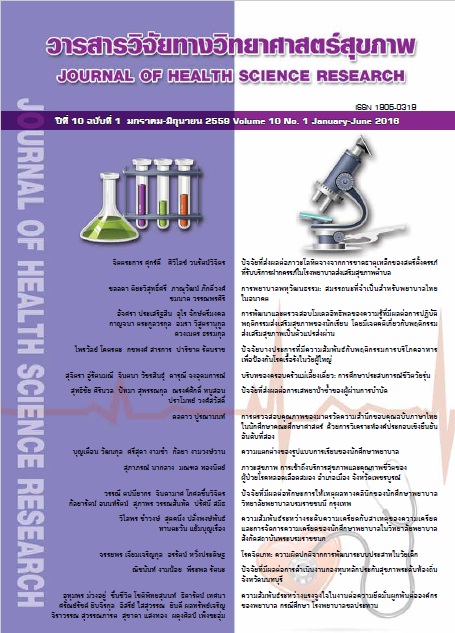ภาวะสุขภาพ การเข้าถึงบริการสุขภาพและคุณภาพชีวิตของผู้ป่วยโรคหลอดเลือดสมอง อำเภอเมือง จังหวัดเพชรบูรณ์
Main Article Content
บทคัดย่อ
บทคัดย่อ
การศึกษาครั้งนี้เป็นการศึกษาแบบภาคตัดขวาง (Cross-sectional research) มีวัตถุประสงค์เพื่อศึกษาภาวะสุขภาพ
การเข้าถึงบริการสุขภาพ คุณภาพชีวิตและปัจจัยที่มีความสัมพันธ์กับคุณภาพชีวิตของผู้ป่วยโรคหลอดเลือดสมอง กลุ่มตัวอย่าง
เป็นผู้ป่วยโรคหลอดเลือดสมอง จำนวน 320 คน เก็บข้อมูลโดยใช้ แบบบันทึกข้อมูลส่วนบุคคล แบบประเมินการเข้าถึงบริการสุขภาพและการปฏิบัติกิจวัตรประจำวัน แบบประเมินภาวะซึมเศร้า และแบบวัดคุณภาพชีวิต วิเคราะห์ข้อมูลด้วยสถิติเชิงพรรณนาและ
ค่าสัมประสิทธิ์สหสัมพันธ์เพียร์สัน ผลการศึกษาพบว่า กลุ่มตัวอย่างส่วนใหญ่เป็นเพศหญิง ร้อยละ 62.50 อายุเฉลี่ย 65.75 ปี มาตรวจตามนัดครบร้อยละ 73.75 ส่วนใหญ่ใช้สิทธิ์การรักษาในระบบประกันสุขภาพร้อยละ 78.75 และเคยได้รับบริการดูแลสุขภาพที่บ้านร้อยละ 68.75 การประเมินความสามารถในการปฏิบัติกิจวัตรประจำวันอยู่ในระดับสูง (= 79.39, SD = 25.04) มีภาวะซึมเศร้าอยู่ในระดับปานกลาง (
= 24.56, SD = 9.89) และคุณภาพชีวิตอยู่ในระดับดี (
= 52.84, SD = 9.48) โดยมิติข้อจำกัดเนื่องจากปัญหาทางร่างกายมีคะแนนเฉลี่ยสูงสุดเท่ากับ 60.92 (SD = 24.41) มิติการมีชีวิตมีคะแนนเฉลี่ยต่ำสุดเท่ากับ 45.89 (SD = 17.39) และความสามารถในการทำกิจวัตรประจำวันมีความสัมพันธ์ทางลบในระดับต่ำกับภาวะซึมเศร้า (r = - .25, p < 0.001) และมีความสัมพันธ์ทางบวกในระดับต่ำกับคุณภาพชีวิต (r = .44, p < 0.001) นอกจากนี้ยังพบว่าภาวะซึมเศร้ามีความสัมพันธ์ทางลบในระดับต่ำกับคุณภาพชีวิต (r = - .54, p < 0.001) ผลการศึกษานี้สามารถนำไปใช้เป็นข้อมูลในการวางแผนพัฒนารูปแบบการให้บริการผู้ป่วยโรคหลอดเลือดสมอง โดยเฉพาะการดูแลด้านจิตใจเมื่อผู้ป่วยเกิดภาวะซึมเศร้า รวมถึงการส่งเสริมสมรรถนะทางด้านร่างกาย เพื่อช่วยให้ผู้ป่วยโรคหลอดเลือดสมองมีคุณภาพชีวิตที่ดี
Abstract
The purpose of this cross-sectional descriptive research was to explore health status, health access,
quality of life as well as factors affecting quality of life of stroke patients. The samples were 320 stroke patients living in Muang District, Phetchaboon Province who voluntarily participated in the study. Research instruments included the demographic data record, Barthel ADL Index, the Center for Epidemiologic Studies-Depression Scale and Short-Form-Health Survey Version 2 Questionnaires. Data were analyzed by descriptive statistics and Pearson correlation coefficient.The majority of stroke patients were female (62.50), mean 65.75 years (SD = 12.27), 78.75 and 68.75
percent of all patients used the universal coverage and received health care services at home respectively. The ability to perform daily activities was in a high level
( = 79.39, SD = 25.04). Patients’ depression and their quality of life were in the moderate level (= 24.56, SD = 9.89) and high level (
= 52.84, SD = 9.48) respectively. Physical dimensions among patients were at highest score (
= 60.92, SD = 24.41) whereas lowest score was the found for physical pain (
= 45.89, SD = 17.39). The ADL had low negative correlation with depression (r = - .25, p < 0.001) and correlated slightly positively with the level of quality of
life (r = .44, p < 0.001). There was a negative significant correlation between patients’ depression and quality of life (r = - .54, p < 0.001). The results can help to create a care plan for
stroke patients with depression, promoting both physical performance and quality of life.
Downloads
Article Details
บทความที่ได้รับการตีพิมพ์เป็นลิขสิทธิ์ของวิทยาลัยพยาบาลบรมราชชนนี จังหวัดนนทบุรี
ข้อความที่ปรากฏในบทความแต่ละเรื่องในวารสารวิชาการเล่มนี้เป็นความคิดเห็นส่วนตัวของผู้เขียนแต่ละท่านไม่เกี่ยวข้องกับวิทยาลัยพยาบาลบรมราชชนนี จังหวัดนนทบุรี และคณาจารย์ท่านอื่น ในวิทยาลัยฯ แต่อย่างใด ความรับผิดชอบองค์ประกอบทั้งหมดของบทความแต่ละเรื่องเป็นของผู้เขียนแต่ละท่าน หากมีความผิดพลาดใด ๆ ผู้เขียนแต่ละท่านจะรับผิดชอบบทความของตนเองแต่ผู้เดียว


